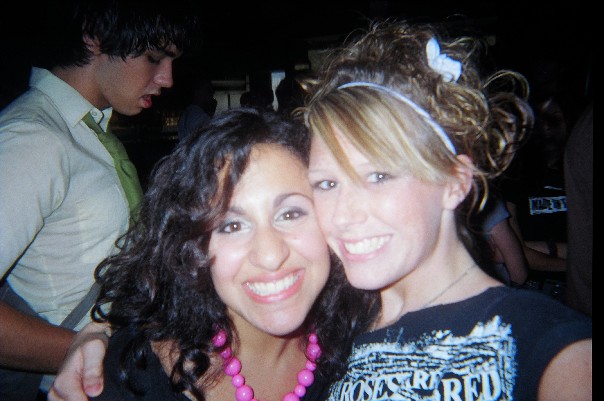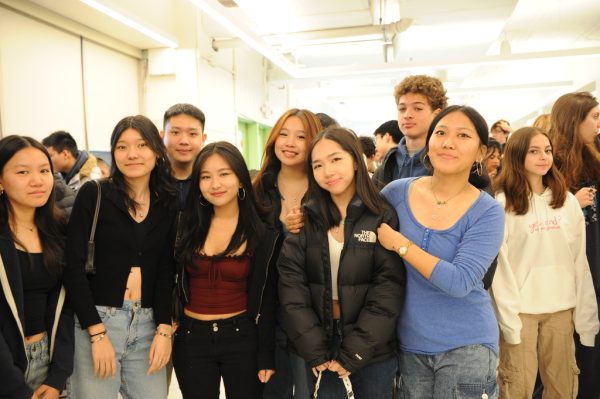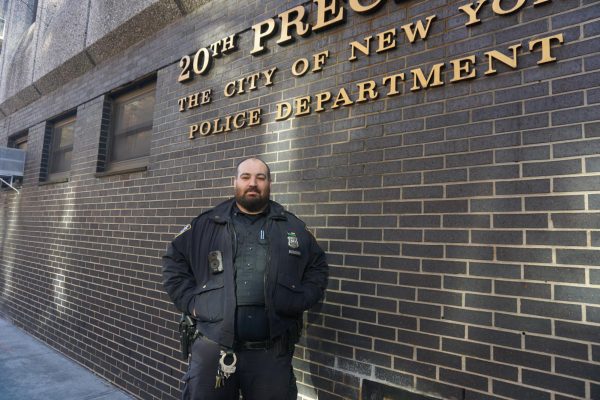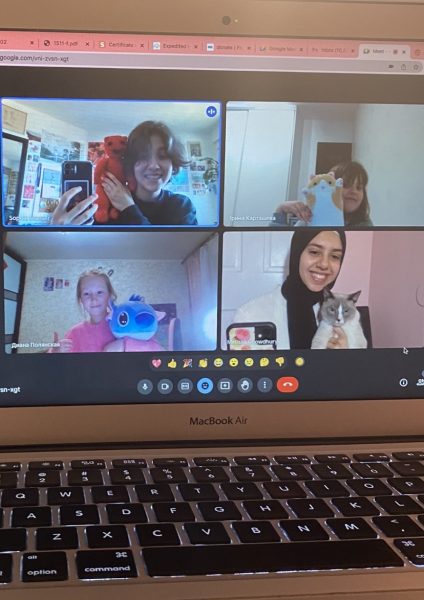Rhapsodies in School
Eight Bronx Science teachers allow us to delve into their music playlists – and tell us the stories that make them so special.
Here is Ms. Daly (pictured at right), a Bronx Science Chemistry teacher, at a local concert during her senior year of high school in the year 2005, with one of her friends.
When Henry Wadsworth Longfellow said that music was the universal language of mankind, he was probably talking about the magic that a song holds, one that is defiant of time and age, and of life and death. That magic explains how Blondie’s 1978 hit One Way or Another was one of Mr. Thorp’s favorites in his teenage years before it became a staple on my own “angsty teenager” playlists in 2016. Of course, there’s a chance that Longfellow meant his statement literally, in which case I’d like to propose that all of our lessons be taught in song form and all exams in the form of riff-offs.
It’s clear that we have some karaoke aficionados among the Bronx Science faculty members, whether it is Ms. Daly’s rendition of Alanis Morissette’s Head Over Feet or Mr. Farley’s Ike Turner imitation during Proud Mary – complete with his wife duetting as Tina Turner. If you want something to sing along to, Ms. Pedraza and Ms. Perez’s go-tos, Guns n’ Roses Sweet Child O’ Mine and The Spice Girls’ Wannabe, respectively, are karaoke favorites, but only the most elite will be able to compete with Mr. Davis when he channels his inner Ol’ Blue Eyes for Summer Wind.
To get a more accurate reading of the eight surveyed teachers’ tastes, I asked them how they felt about today’s popular music. Yes, pop music is a relative term, but for the purposes of my question, it’s defined as the chart-topping hits of the 2010s and 2020s. For reference, the ten songs dominating Spotify’s Global Chart today are by artists such as Olivia Rodrigo, SZA, Doja Cat, 24kGoldn, Ariana Grande, Dua Lipa, and Morgan Wallen.
Ms. Daly, Ms. Pedraza, and Mr. Scheiber seem the most enthused about today’s pop music, with Ms. Daly noting, “I also like how all music doesn’t fit into specific boxes!” and Mr. Scheiber expressing gratitude for his students, who keep him up to date. “I have been asking my students to suggest songs to play at the beginning of class. My A.P. Chemistry class likes BTS, and my students got me into this group. I enjoy their mellow tones to help end the day on a nice note,” Scheiber said. Ms. Pedraza was the most complimentary by far, describing herself as a “fan of the vast majority. I’ll listen to the radio, and I usually like what I hear, particularly songs by Ariana Grande, Lady Gaga, or Billie Eilish.”
Mr. Chomet and Mr. Farley both took more diplomatic stances, with Mr. Chomet expressing hope for the future. “I’m happy that it seems like pop is trending back towards a more melodic style. The 2010s had so many songs with one or two-note melodies that I found really irritating,” Chomet said. Mr. Farley admits that pop music is fun when administered in small doses, especially when it’s the K-pop girl group BLACKPINK. Not everyone was given that option, however. Ms Perez spent the better part of quarantine last Spring 2020 listening to Disney movie soundtracks and the two Trolls soundtracks, courtesy of her daughter Leia. When asked for her take on pop music, to my astonishment, Ms Perez said she enjoyed “…some of the songs, but definitely not all…” which proves that she is definitely the most patient person on Earth.
Next, Mr. Thorp discussed his affinity for the popular music of the late 1980s and early 1990s, but when it comes to the more recent music, the only thing he had to say is, “I don’t keep up with any popular music, currently.” Mr. Davis expressed the same sentiment, but opted for a much shorter answer: “Meh.”
My next step was to ask our teachers what songs defined the times they grew up in. I created a point of reference by loosely defining my age group (2003-2007) by the popularity of artists such as Justin Bieber, Beyonce, One Direction, Katy Perry, Taylor Swift, Ariana Grande, and Bruno Mars.
Mr. Thorp and Mr. Davis initially suggested Freeze Frame by J. Geils Band (1981) and Unchained by Van Halen (1981) respectively, and both chose Violent Femmes’ 1983 hit Blister in the Sun. Ms. Daly attributes the anachronism of her childhood preferences to her oldie-obsessed parents, who she lovingly refers to as hippies. Specifically mentioned are Brown Eyed Girl (1967) by Van Morrison, Octopus’s Garden, (1969) by The Beatles, Chubby Checker’s The Twist, (1960) and Riders on the Storm (1971) by The Doors. Ms. Perez’s childhood in Colombia introduced her to both English and Spanish music, including to ¿Donde Estas Corazon? (1995) by Shakira, Wannabe (1996) by Spice Girls, Mal Bicho (1995) by Fabulosos Cadillacs, and Ironic (1996) by Alanis Morissette. For truly eclectic tastes, look no further than Mr. Chomet, who defined his childhood using Free as a Bird (1977/1995) by the Beatles, Pinball Wizard (1969) by The Who, No Diggity (1996) by Blackstreet, and Stellar (1999) by Incubus. As expected, our teachers’ tastes have changed, but they still find time for their original favorites, even the embarrassing ones.
Before reading the answers given by our eight teachers, I’d like to invite everyone to think about their own answer to this question: If you could meet any musician, dead or alive, who would it be? What would you ask them?
Mr. Thorp says he’d go back to the 18th century to meet Johann Sebastian Bach, but only to ask him a logistical question…“He had 20 children; how did he have the time to write so much glorious music?” This isn’t an overstatement, Bach actually did have 20 children. He also had the same 24 hours as the rest of us, so it’s anyone’s guess as for when he found the time to write his Cello Suites, not to mention the other thousand works.
Ms. Daly and John Lennon would discuss the style change in The Beatles’ music from Please Please Me all the way to Let It Be, but Ms. Pedraza just wants to ask Paul if he was fibbing when he said that none of the Fab Four could read music.
Mr. Farley wants to meet three of his jazz heroes, John Coltrane, Thelonious Monk, and Charlie ‘Bird’ Parker, “because their musical genius was on another level.”
Ms. Perez would sit down with Andres Calamaro because “his lyrics are like poetry,” and Mr. Davis said he would sit down with the late great Chris Cornell for the same reason. Mr. Chomet would talk to Herbie Hancock, a man who definitely has stories that are as captivating as his skills when he sits down at a piano. Mr. Scheiber was positive he would sit with Taylor Swift, who he believes has had an equal impact on modern music and the way many of us view the world today.
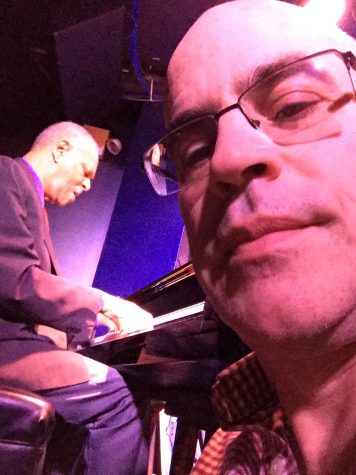
Finally, if you could only listen to one song for the rest of your life, what would it be?
Mr. Thorp, English teacher: Six Cello Suites – J.S. Bach
Mr. Scheiber, Chemistry teacher: Call Me Maybe – Carly Rae Jepsen
Ms. Pedraza, Mathematics teacher: Bohemian Rhapsody – Queen
Mr. Farley, Physical Science teacher: “I’ll pass. No matter how much I like it now, I know I’ll get sick of it.”
Ms. Perez, Mathematics teacher: De Musica Ligera – Soda Stereo
Mr. Chomet, Biology teacher: Suite: Judy Blue Eyes – Crosby, Stills, Nash, and Young
Mr. Davis, History teacher: Burden in My Hand – Soundgarden
Ms. Daly, Chemistry teacher: Norwegian Wood – The Beatles
When Henry Wadsworth Longfellow said that music was the universal language of mankind, he was probably talking about the magic that a song holds, one that is defiant of time and age, and of life and death.
Maanya Shah is an Arts and Entertainment Editor for ‘The Science Survey.' She finds that journalistic writing is the perfect way to balance creative...

